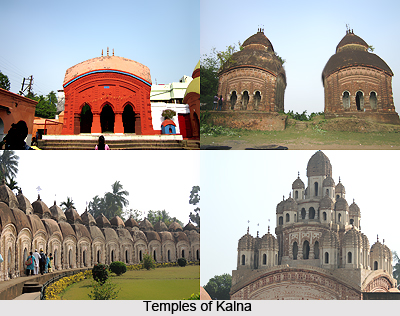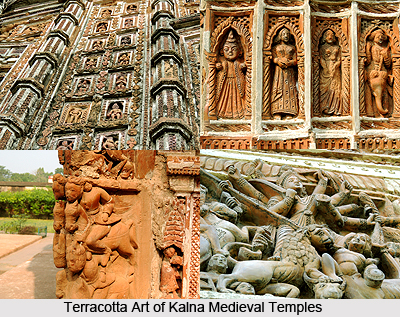 Kalna or Ambika Kalna is a temple town, a municipality and head quarters of Kalna subdivision in Bardhaman District in West Bengal. It is situated on the western bank of the Bhagirathi River. The Kalna town is more popularly known as Ambika Kalna. It is named after a popular deity of Goddess Kali, Maa Ambika. Kalna has numerous historical monuments such as the Palace of Kalna (Rajbari) and the 108 Lord Shiva temples.
Kalna or Ambika Kalna is a temple town, a municipality and head quarters of Kalna subdivision in Bardhaman District in West Bengal. It is situated on the western bank of the Bhagirathi River. The Kalna town is more popularly known as Ambika Kalna. It is named after a popular deity of Goddess Kali, Maa Ambika. Kalna has numerous historical monuments such as the Palace of Kalna (Rajbari) and the 108 Lord Shiva temples.
Location of Kalna
The town of Kalna, is 60 kilometres from Bardhaman. Kalna is located at 23°13`N to 88°22`E. It has an average elevation of 11 metres from the sea level. The town can easily be accessed by rail or roadways. It is connected from Howrah towards Katwa. Ambika Kalna, 81 kilometres from Howrah, is the main railway station. There are several local trains as well as express trains, on the route and almost all of them stop at the Ambika Kalna rail station. By road, the town can be accessed from primarily 4 places, Bandel, Pandua, Bainchi and Barddhaman. Kalna is situated on the agriculturally rich alluvial soil between the Bhagirathi, Ajay River and Damodar River
Though part of the Burdwan district of West Bengal, Kalna is located near the border with Nadia District and Hooghly District. Near Kalna there is a famous pilgrimage place called Nabadwip and Mayapur, famous for the centre of ISKCON.
Climate of Kalna
The temperature in this region varies from 17-18 °C in winter months to 30-32 °C in summer seasons.
Tourism in Kalna
Kalna reached its pinnacle of glory during the late 18th century under the patronage of the Maharajas of Bardhaman. They built several magnificent temples with intricate terracotta ornamentation. The maritime trade has long stopped and Kalna has lost the status of a flourishing port city, but the temples are still there reminding one of Kalna`s glorious past.
 Apart from the temples, Kalna has several religious structures dedicated to Sree Chaitanya one of the greatest social reformers of Bengal. It is located just 82 kilometers from Kolkata. Now Kalna is ideal pilgrimage.
Apart from the temples, Kalna has several religious structures dedicated to Sree Chaitanya one of the greatest social reformers of Bengal. It is located just 82 kilometers from Kolkata. Now Kalna is ideal pilgrimage.
The Rajbari (palace) complex in Kalna has the maximum concentration of temples. Spread on either side of a metalled road, the complex contains a unique mixture of Bengal`s temple architecture. On one side of the road lies the Nabakailas Temples.
The Nabakali temple was built in 1809 by the Bardhaman Maharaja Tej Chandra Bahadur. The temple complex contains 108 "Aat-chala" (eight sloped roofed) temples arranged in two concentric circles separated by a well-maintained lawn with beautiful flowerbeds. The outer circle consists of 74 temples consisting of alternate black and white lingas while the 34 temples of the inner circle have only white lingas.
On the other side of the metallic road of Rajbari lies a walled complex, containing the most diversified form of Bengal`s temple architecture. The cynosure of Kalna is the Pratapeshwar Temple, with its elegant shape and rich terracotta ornamentation. It was built in the year of 1849 in Deul (Spire) style the temple contains terracotta plaques. It depicts the themes of Hindu epic, mythical life of Sree Chaitanya, images of Goddess Durga and Ravana and various aspects of day to day life.
The other two star attraction of the complex are Lalaji Mandir and Krishnachandra Mandir. Both temples are three-storied Panchavimsatiratna (25 pinnacled). The Lalaji Temple was built in 1739 and is the oldest temple in the Rajbari complex. It is fronted by a "Char-chala" (four sloped roof) Mandap. The temples also have some beautiful terracotta panels. The Krishnachandra temple built in 1751-55 is very similar in structure to the Lalji Mandir. The complex also houses several minor structures like a roofless Rash Mancha, several Aat-chala structures among which a flat roofed temple of Giri Govardhan needs special mention.
Bhaduri-para also has a large collection of temples including the Panchavimsatiratna that is 25 pinnacled temple of Gopalbari. But the holiest attraction of Bhaduri-para is the Siddheswari Temple. It is dedicated to the Mother Goddess Ambika or Lordess Kali. Built in 1740 AD by Chitra Sen, the then Maharaja of Bardhaman, this shrine is considered to be the most auspicious one in the town. The Char-Chala structure reached by a flight of 14 beautifully curved steps (signifying nine planets and the five tantric cults) houses the image of auspicious Bamakali Idol, built of a single neem log. The complex also contains three Shiva Temples. The nearby Ananta-Vasudev Mandir is another interesting terracotta structure is centre of attraction of Kalna.






